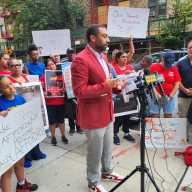The city is launching a wave of public events to give Bronxites the opportunity to be heard as efforts to reimagine the Cross Bronx Expressway are underway.
The city was awarded $2 million through a U.S. Department of Transportation Rebuilding American Infrastructure with Sustainability and Equity (RAISE) two-year grant to conduct a study of the expressway, which was announced in December.
The study has not begun yet, and the public engagement process will guide its formation, a NYC Department of Transportation (DOT) spokesperson told the Bronx Times.
According to Mayor Eric Adams, the study will look at ways to reduce pollution and noise, improve safety and sustainability and reconnect communities that had been torn apart by the expressway’s construction. More specifically, the government agencies will look at strategies for decking parts of the expressway — also known as capping — to create new public open space above the highway, according to Adams’ announcement.
“It’s time we prioritize environmental justice and address the harms that 20th century highways have caused communities, largely communities of color, across our city,” NYC DOT Commissioner Ydanis Rodriguez said in a statement. “Together, with the support of Mayor Adams, we are seizing a pivotal opportunity to reconnect communities that have been divided by this highway.”
Built between 1948 and 1963 under the auspices of famed planner Robert Moses, the roadway’s construction ripped apart neighborhoods, destroying homes and displacing thousands.
The neighborhood of East Tremont is commonly highlighted as a site of displacement, though an interactive map published in a New York Times opinion piece by architect Adam Paul Susaneck shows the scale of the highway’s path. Robert Caro, the author of “The Power Broker,” a widely cited biography on Moses, described East Tremont as a predominately Jewish community that saw an influx of Black and Puerto Rican residents after World War II.
The Cross Bronx has long been a symbol of environmental racism, leaving predominately Black and Hispanic communities in the South Bronx with disproportionately high asthma rates.
“The Cross-Bronx Expressway is literally and metaphorically a structure of racism from which me and so many others in the Bronx live with the consequences of,” U.S. Rep. Ritchie Torres, who represents parts of the borough, said at the December announcement.
The city plans to present a multiyear plan with short- and long-term project proposals to improve neighborhood conditions around the expressway by 2024, according to the mayor’s announcement of the study.
After the study is created, the city and state can tap available funds for the project from the federal Bipartisan Infrastructure Law, and the city and state will pursue any other relevant federal grants for funding, the DOT spokesperson told the Bronx Times.
Through the public meetings, Bronxites can share how they’ve been impacted by the highway and what they would like to see built, said Edith Hsu-Chen, executive director of the NYC Department of City Planning.
“Together with Bronx communities, Mayor Adams, and partners throughout government, we are crafting a holistic vision for the Cross Bronx Expressway corridor to envision a cleaner, healthier borough and remedy mistakes of the past,” Hsu-Chen said in a statement.
Register for the online and in-person open houses at: bit.ly/CrossBronxEvents.
Virtual events will take place on Thursday, March 30 and Monday, April 10, both from 6 p.m. to 8 p.m.
The in-person events will take place at the following:
- Saturday, April 1, 11 a.m.-2 p.m. at the Bronx River Art Center, 1087 East Tremont Ave.
- Monday, April 3, 6 p.m.-9 p.m. at the Davidson Community Center, 2038 Davidson Ave.
- Tuesday, April 4, 5 p.m.-8 p.m. at PS 106 Parkchester Elementary School (Cafeteria), 1514 Olmstead Ave.
DOT will also conduct four rounds of public workshops in addition to these open houses, the spokesperson said.
There will also be a public survey, pop-up outreach in neighborhoods along the Cross Bronx Expressway corridor and meetings with community groups, according to DOT.
This article was updated at 12:12 a.m. on March 25 to provide additional context surrounding the displacement of Bronx residents during the time period when the Cross Bronx Expressway was being built.
Reach Aliya Schneider at aschneider@schnepsmedia.com or (718) 260-4597. For more coverage, follow us on Twitter, Facebook and Instagram @bronxtimes




















